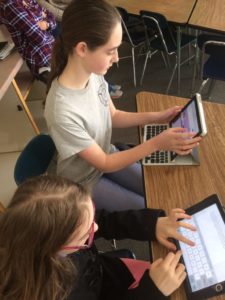Peoples Academy Middle Level and Stowe Middle School recently highlighted on the Tarrant Institute for Innovative Education's Blog: READ ALL ABOUT IT!
Peers partner on portfolios
 Students at two Vermont schools have begun working together as “Portfolio Partners” to curate evidence, reflect on their growth, and prepare to share their learning with a wider audience.
Students at two Vermont schools have begun working together as “Portfolio Partners” to curate evidence, reflect on their growth, and prepare to share their learning with a wider audience.
Here’s how it works.
Why peer partnering?
Robyn Alvin, an educator at Stowe Middle School, in Stowe VT, shares why she feels so strongly about creating time for peer-to-peer connections:
“While students get feedback from their teachers whether they want it or not, they naturally and consistently look for feedback from their peers. When we as their teachers, organize the structure of lessons to allow for, and expect, collaboration between our students, they will naturally be more engaged.
As the REAL Framework supports: “…when students are strongly engaged they are successfully involved in tasks of high intellectual quality and they have passionate positive feelings about these tasks”.
We want our students to be engaged and fluent in high order skills like analyzing and synthesising, so why not utilize their interest in working directly with peers?”
What peer partnering looks like
At Peoples Academy Middle Level, in Morrisville VT, 7th and 8th grade students work together as “Portfolio Partners” to prepare for their upcoming Portfolio Fair. Partner pairs help each other select and upload photos of original artwork, and provide feedback on each others’ reflective writing.
PAML’s 7th & 8th Grade PLP portfolio requirements:
- All students goals are written in SMART goals format;
- Each portfolio must end up with a completed About Me, Goals, and Reflections section;
- Each goal must have one reflection per week (equaling 4 reflections per goal);
- The portfolio should reflect PAML’s Scholarly Habits guidelines;
- The portfolio should show evidence of Reflective Writing.
In addition to teacher conferencing and classroom opportunities, students at Peoples Academy have time during their flexible Friday schedule to work with a peer.
Partners review each other’s progress from the week, and give each other feedback, tips, and technology help. Partners also use a learning scale to measure their Scholarly Habit of persistence throughout these four weeks. Prior to the Portfolio Fair, partners will be given time to practice their portfolio presentation skills with each other and become proficient with their presentation before they go “live”.
How else can peer partnering work?
Honoring students as partners in this work is not limited to Peoples Academy. Another school in the district, Stowe Middle School, provides their students many guided opportunities to give each other feedback.
One example is their student-led assemblies where a committee of 6th grade students, led by their teacher, select exemplary PLPs and invite the creators to present to the entire middle level.

6th grade students at Stowe Middle School listen as one of their peers explains how he assembled his PLP.
What can peer partnering look like between schools?
Stowe Middle and Peoples Academy teachers are now in the initial stages of collaboration to make cross-school peer-to-peer partnerships happen.

Google Hangout makes it possible for peer teachers at different schools to partner around this important work.
Building on the success of past experiments connecting students outside the classroom walls to provide peer feedback, representatives from each school’s leadership team met to coordinate peer-to-peer connections. They did so using Google Hangouts, the same technology their students will be using.
How it works:
- The two schools start students with icebreaker activities via Google Hangout.
- After that, teachers identify student partnerships based on common interests.
- Student partners provide each other with formative feedback on their portfolios prior to presentation. They also have the opportunity to attend each others’ Portfolio Presentation days. Nothing makes a lesson more real than in-person experience!
What structures this work?
The two schools are tapping into a district-wide Proficiency-Based Learning initiative by sharing a common set of learning targets for both scholarly habits and transferable skills. This will focus the work and provide a common language for reflection.
Peoples Academy is using this scale on evaluating transferable skills:
And Stowe brought their Mission Related Goals menu:
Where can peer partnering lead?
I sat in on a peer partnering session at Peoples Academy, circulating the room, checking in on partner progress. One student, Kate, had her iPad browser open to the definition of the word turbulent. Curious, I asked about the word and what made her interested in its definition.
Kate shared she had clicked on her My Future tab and was reminded of her results from the Meyers Briggs survey she took last year as a 7th grader. She wanted to understand better why the results showed her as 80% turbulent. She was a combination of curious and self-reflective as she tried to make sense of this data she hadn’t visited in over a year.
Kate suggested to her teacher that the class taking the survey again, even though it was time consuming, to see if and how she and her classmates had changed. Her teacher agreed the time spent on the survey would be well worth it since the results provide a window into ways to explore growth and change over time.
“Learning-edge cultures create a hunger for, rather than a dread of, assessment and feedback. This happens when assessment and feedback is challenging and supportive, connecting with the students’ understanding of where they are trying to go and why—and what will help them to get there.” The Learning Edge



